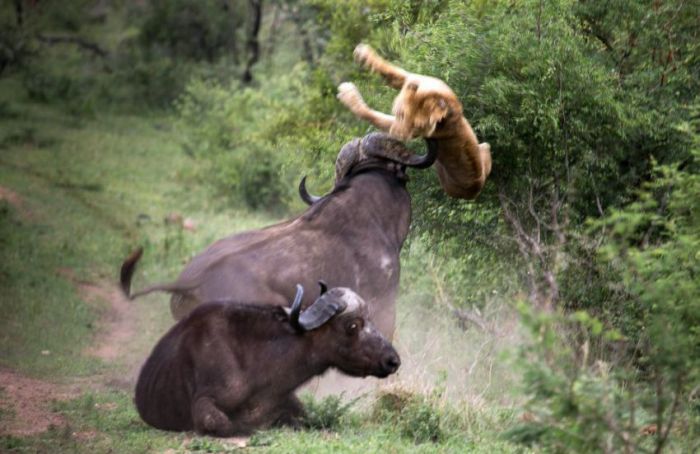|
|
Lioness Against A Buffalo With Friends
|
African buffaloes make various vocalizations. Many calls are lower-pitched versions of those emitted by domestic cattle. They emit low-pitched, two- to four-second calls intermittently at three- to six-second intervals to signal the herd to move. To signal to the herd to change direction, leaders will emit “gritty”, “creaking gate” sounds. When moving to drinking places, some individuals make long maaa calls up to 20 times a minute. When being aggressive, they make explosive grunts that may last long or turn into rumbling growl. Cows produce croaking calls when looking for their calves. Calves will make a similar call of a higher pitch when in distress. When threatened by predators, they make drawn-out waaaa calls. Dominant individuals make calls to announce their presence and location. A more intense version of the same call is emitted as a warning to an encroaching inferior. When grazing, they will make various sounds, such as brief bellows, grunts, honks and croaks.
• Reproduction
Buffaloes mate and give birth only during the rainy seasons. Birth peak takes place early in the season, while mating peaks later. A bull will closely guard a cow that comes into heat, while keeping other bulls at bay. This is difficult, as cows are quite evasive and attract many males to the scene. By the time a cow is in full estrus, only the most dominant bull in the herd/subherd is there.
Cows first calve at five years of age, after a gestation period of 11.5 months. Newborn calves remain hidden in vegetation for the first few weeks while being nursed occasionally by the mother before joining the main herd. Older calves are held in the centre of the herd for safety. The maternal bond between mother and calf lasts longer than in most bovids. However, when a new calf is born, the bonding ends and the mother will keep her previous offspring at bay with horn jabs. Nevertheless, the yearling will follow its mother for another year or so. Males leave their mothers when they are two years old and join the bachelor groups. Young calves, unusually for bovids, suckle from behind their mothers, pushing their heads between the mothers' legs.
|
|









